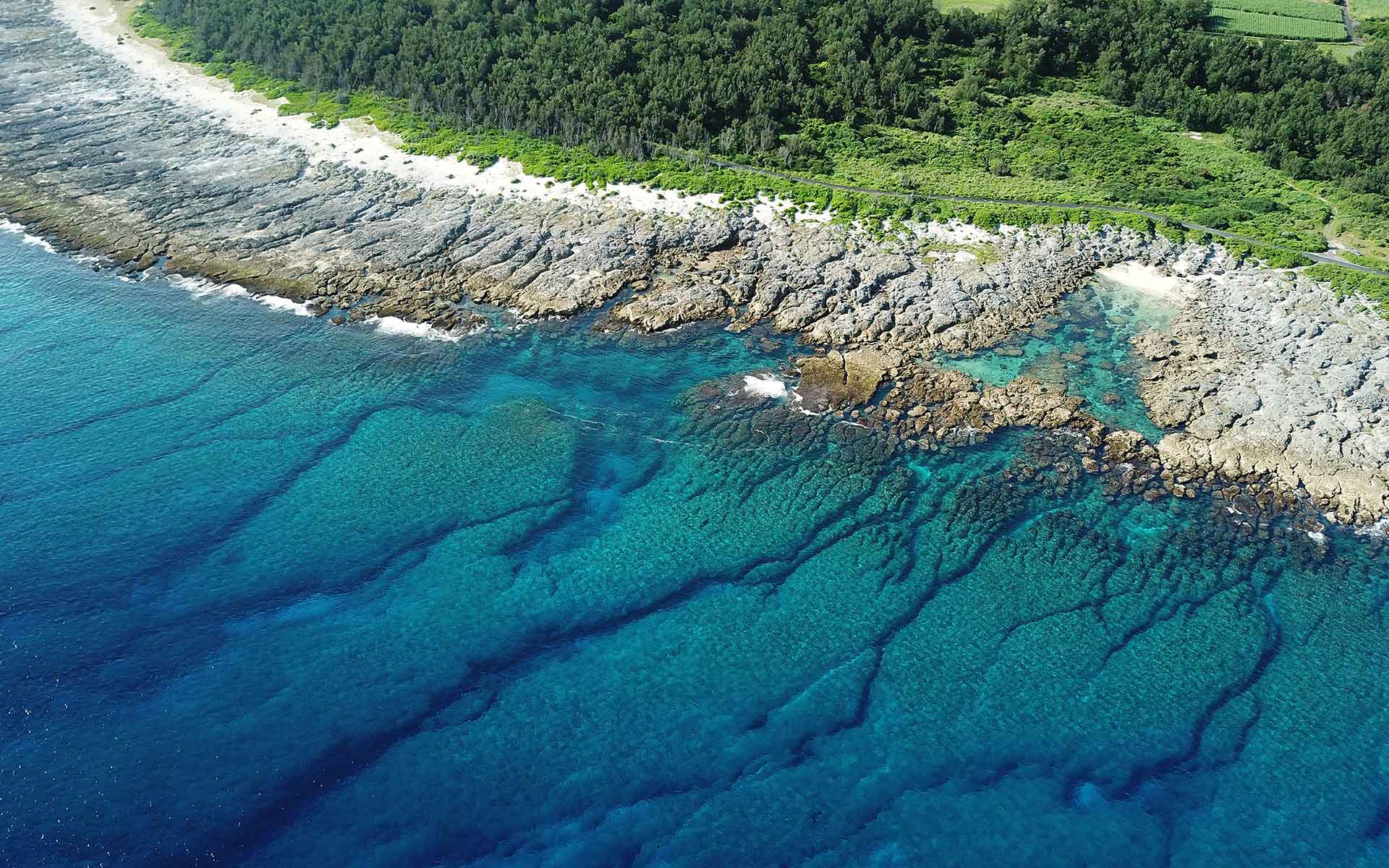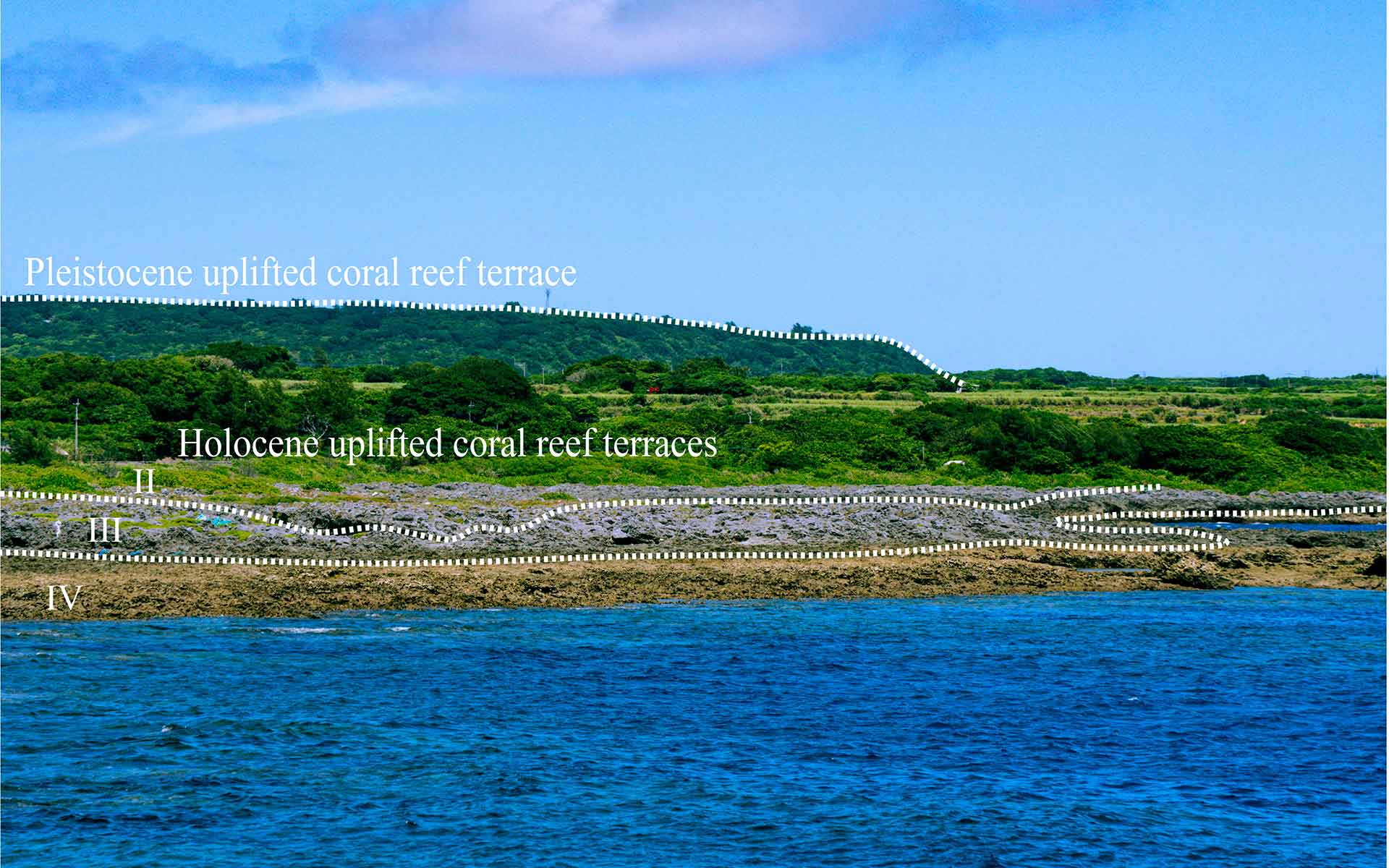
Uplifted coral reefs along the coastline of Kikaijima Island (photo by Kaito Fukuda).
Geological Period
Pleistocene to Holocene
Main geological interest
Stratigraphy and sedimentology
Tectonics
Location
Forearc region of Ryukyu, Kagoshima Prefecture, Japan
28°17’31”N, 129°57’51”E
Uplifted coral reefs along the coastline of Kikaijima Island (photo by Kaito Fukuda).
History of coral reefs over a period of 100,000 years recorded changes in climate, sea level, and ecosystem.
Researchers have attempted to describe and date the terraces of Kikaijima Island, providing a detailed record of sea-level changes during the last glacial cycle and periodic (6.3, 4.1, 3.1, and 1.4 ka) seismic uplift events (e.g., Sugihara et al., 2003; Sasaki et al., 2004; Inagaki and Omura, 2006).
The remarkable uplift rates have exposed well-preserved, fresh coral skeletons, which enable detailed climatic reconstructions during the Holocene (e.g., Garas et al., 2022).
- Geological description
The unique coral reef terraces of Kikaijima Island were formed by rapid sea-level changes during the late Pleistocene glacial cycle, with seafloor uplift at an extremely high rate. For the past 100,000 years, the Kikaijima Island has been ascending at a rate of 2.1–2.3 m/ky (Inagaki and Omura, 2006). These terraces are built upon the foundation of Ryukyu Group and have experienced continuous development and repeated uplift of coral reefs. These coral reef terraces correspond with the interglacial highstands of sea-level. The contrast between the terrace surfaces and cliffs, formed from the coral reefs during this cycle, creates a beautiful stepped topography, serving as a remarkable record of late Pleistocene sea-level changes, including marine isotope stage 3 (Sasaki et al., 2004). The consistent uplift rate on Kikaijima Island has been maintained since the late Pleistocene, and the series of four terraces and cliffs provide a record of past seismic activity occurring on a millennial scale. Furthermore, well-preserved coral fossils from Holocene reefs have been used as continuous paleoclimatic indicators for the North western Pacific (Garas et al., 2022).
- Scientific research and tradition
The geology and topography of Kikaijima Island has been studied since the 1930s. Dating methods for coral fossils revealed that the terraces on the island correspond to eustatic sea-level changes (e.g., Omura and Ota, 1992; Sasaki et al., 2004). This island plays a crucial role in studying human-induced global environmental changes, including changes in coral community composition and paleoclimatic reconstructions (e.g. Abram et al., 2001).
- Reference
Abram, N. et al. (2001) ‘Biological response of coral reefs to sea surface temperature variation: evidence from the raised Holocene reefs of Kikai-jima (Ryukyu Islands, Japan)’, Coral Reefs, 20(3), pp. 221–234. Available at: https://doi.org/10.1007/s003380100163.
Garas, K.L., Watanabe, T. and Yamazaki, A. (2023) ‘Hydroclimate seasonality from paired coral Sr/Ca and δ18O records of Kikai Island, Southern Japan: Evidence of East Asian monsoon during mid-to late Holocene’, Quaternary Science Reviews, 301, p. 107926. Available at: https://doi.org/10.1016/j.quascirev.2022.107926.
Inagaki, M. and Omura, A. (2006) ‘Uranium-series Age of the Highest Marine Terrace of the Upper Pleistocene on Kikai Island, Central Ryukyus, Japan’, The Quaternary Research (Daiyonki-Kenkyu), 45(1), pp. 41–48. Available at: https://doi.org/10.4116/jaqua.45.41.
Omura, A. and Ota, Y. (1992) ‘Paleo sea-level change during the last 300 000 years deduced from the morpho-stratigraphy of coral reef terraces and 230Th/234U ages of terrace deposits’, The Quaternary Research (Daiyonki-Kenkyu), 31(5), pp. 313–327. Available at: https://doi.org/10.4116/jaqua.31.313.
Sasaki, K. et al. (2004) ‘Interstadial coral reef terraces and relative sea-level changes during marine oxygen isotope stages 3–4, Kikai Island, central Ryukyus, Japan’, Quaternary International, 120(1), pp. 51–64. Available at: https://doi.org/10.1016/j.quaint.2004.01.006.
Sugihara, K. et al. (2003) ‘Holocene sea-level change and tectonic uplift deduced from raised reef terraces, Kikai-jima, Ryukyu Islands, Japan’, Sedimentary Geology, 159(1), pp. 5–25. Available at: https://doi.org/10.1016/S0037-0738(03)00092-7.
- Author(s)
Taro Komagoe.
KIKAI institute for Coral Reef Sciences. Japan.
Atsuko Yamazaki.
Nagoya University /KIKAI institute for Coral Reef Sciences. Japan.
Takayasu Amano.
Kikai Town Office. Japan.
Rintaro Suzuki.
KIKAI institute for Coral Reef Sciences. Japan.
Yoshitaka Uechi.
Kikai Town Office. Japan.
Tsuyoshi Watanabe.
Hokkaido University / Research Institute for Humanity and Nature / KIKAI institute for Coral Reef Sciences. Japan.


